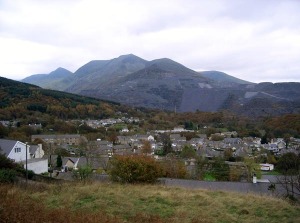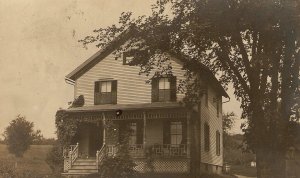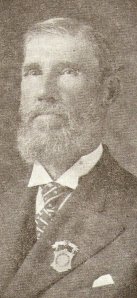Geoffrey Chaucer in his introduction to “The Canterbury Tales” talks of “the droghte of March” (the drought of March), but you know what………….I’m not complaining! In fact, I’m positively rejoicing!
We’ve had a lovely long spell of clear, blue skies with warm periods of sunshine recently and the fields are full of bright white bleating lambs frolicking amongst flocks of vigilant ewes. Spring has definitely arrived and the daffodils that were gradually nudging their way through the soil’s surface in my last blog are now, as Wordsworth said, “tossing their heads in sprightly dance” everywhere over this land I love.
There is a freshness to this time of year and I’m always reminded of the words of one of my very favourite Welsh songs during this period. A song, by the way, which has very strong links with the Slate Valley and with the New Rockland in Canada I mentioned last time. The song in question is “Moliannwn” (pron. molly-ann-oon) and it was written by a Welsh slate quarryman called Benjamin Thomas, who now rests at the Mountain View Cemetery in West Pawlet, Vermont. The music was a traditional American melody called “The Old Cabin Home” and Thomas added his lyrics to the tune sometime during his time working the quarries of the Slate Valley or Quebec. Despite its transatlantic creation, there is no doubting its popularity amongst the people of Wales. I have sung the song countless times in packed pubs when the beer is flowing and the hwyl (pron. who-ill), the legendary Welsh spirit of merriment, is at its highest. I can even recall being over in Dublin a few years ago during a rugby international weekend, when the tide of red-shirted Welsh supporters swamps the city, and hearing the song booming out of a few Irish pubs as I walked by……..such is the popularity of the song over here. But I’m very sure also that not many of the voices I heard then could tell me the origin of the song or explain the strange lyrics despite its status amongst the repertoire of Welsh drinking songs. “Moliannwn” means “Let’s rejoice” or “Let’s give praise” and there is no doubting that it is rooted in the world of the Welsh-American slate quarryman.
Born on April 9, 1838, Benjamin Thomas was a native of the famous slate quarrying town of Bethesda in North Wales, but he spent a good half a century on the North American Continent ending his days in the Slate Valley. He was a man who involved himself in things Welsh, most notably in poetry – he penned several verses which can be found in countless old periodicals of the age. Most are musings upon the vicissitudes of life, but there is no doubt that his most enduring piece is “Moliannwn“, the vigorous song of praise at the arrival of spring.
The first verse kicks off with an exhortation for all to rejoice at the coming of spring. It talks of the passing of cold winter and delights in the new foliage of trees underneath the warm rays of the sun. The stanza ends with a comment upon the new-born lambs prancing on green meadows giddy with the simple joy of life.
The famous chorus then follows – a lively section to be repeated several times in the song in which a slate quarryman’s relief at the coming of spring can be heard. The lines express a new hope after a period of inactivity brought on by the harshness of winter, which given the ferocity of the ones experienced in the US and Canada, is not surprising. The chorus states that much money will be won now and that things are looking better for the upcoming period.For a Welshman in Wales, the next stanza carries a few familiar images, but also a couple that are not so recognisable. The Robin Redbreast, a common bird over here, is said to sing gingerly on the hillside, but then the song begins to acquire an unusual line of lyric. It talks of grasshoppers and toads by the thousand chirpily whistling away from the woods – most definitely not a Welsh phenomenon. I can remember visiting Middle Granville in the summer of 1997 and being amazed by the constant noises of the foreign fauna hidden in the flora of the Slate Valley. Sleeping was quite difficult at first as all I was accustomed to was the odd bleating of a sheep, rather than the chorus of an American night. But the strangest line of all is the one that talks of the “wiparwhil“, the Welsh phonetic spelling of the whippoorwill, a bird alien to our shores. And yet, we’ve sung its name for the last hundred years or so totally oblivious to its Slate Valley source! I can well imagine old Ben Thomas sitting on the porch of his house at night on the outskirts of Granville near the aptly named Bullfrog Hollow listening to the sounds, once alien, that had become so familiar to him.
The third and final stanza talks of going into town to spend your well-earned money on singing and dancing in the company of “enethod lan a theg” (maidens pure and fair), of which I am certain there are a multitude in Granville! But it is the final line that sums up the Slate Valley for me – it is the place “lle mae mwyniant y byd yn disgleirio“, where the joys of the world shines forth! I’ve long since fallen in love with the area and though I’m sitting by a desk in a room in North Wales here I often find myself drifting off to the district where my great-great-grandfather lies.
The present version of the song isn’t exactly its original one. Unbeknownst to most people there were two other verses that talked of New York and Montreal and of young men working under dangerous circumstances, but I won’t go into detail about that now. I’ll leave that to someone I know who is far more eloquent, capable and qualified. And talking of New York………….I’ll be there over Easter in three weeks time with my partner and my three children……….wouldn’t it be great if I could pop up to that place I hold so dear………..hmmmmm………I wonder? And if I could! Well!! “Ffwl-la-la, ffwl-la-la, ffwl-la-la-la-la-la-la / Ffwl-la-la, ffwl-la-la, ffwl-la-la-la-la-la-la!”
Tan tro nesa’!



![Mynd am dro Nantglyn Pasg 2010 026[1]](https://slatevalleymuseum.files.wordpress.com/2011/04/mynd-am-dro-nantglyn-pasg-2010-0261.jpg?w=300&h=225)

